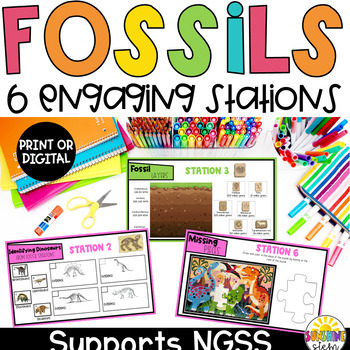Fossil Stations {NGSS Aligned with 3-LS4-1, 4-ESS1-1, MS-LS4-1 & MS-ESS2-3}
- PDF
What educators are saying
Description
⭐⭐NOW IN GOOGLE SLIDES!!!! ⭐⭐
Engage your students in six fun and engaging activity stations that are designed to give students an enriching experience in supporting NGSS standards. Each station provides students with an interesting look at fossils and what they tell us about the past! These stations are part of the unit; All About Fossils, a complete NGSS unit.
Station topics include:
1. Glossopteris Trees, Proof of an Ancient World - Students analyze two different maps in earth's history to see what these tree fossils tell us about earth's ancient landmasses
2. Identifying Dinosaurs from Fossil Skeletons - Students match dinosaur fossils with pictures of dinosaurs before explaining evidence of each match
3. Fossil Layers - Students place pictures of fossils in the correct layer of earth based on time periods and fossil ages
4. How Feathers Evolved - Students watch a short video on feather evolution and evidence that some dinosaurs had feathers
5. Making Mold and Cast Fossils - Students create both mold and cast fossils out of dough or clay
6. Puzzling Fossils - Students become paleontologists as they attempt to complete a puzzle piece with only the information around it. This shows students how paleontologists must figure out fossil skeletons when pieces are missing
Stations can be used as a supplement to your instruction. NGSS standards covered are:
Biological Evolution: Unity and Diversity
Earth's Place in the Universe
Earth's Systems





